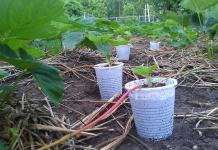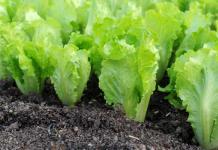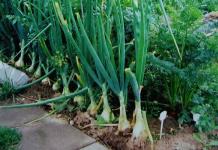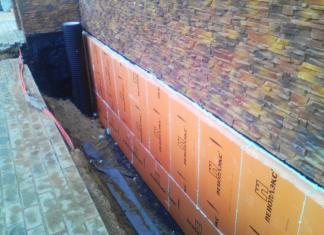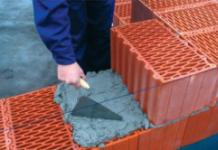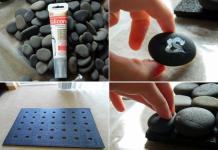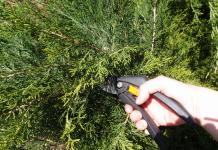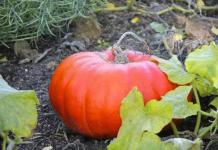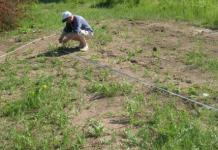The longevity and appearance of the plant depends on how correctly you will take care of the thujas in the fall. When and how to fertilize an evergreen tree and what top dressings it is better to refuse, how to cut it and prepare it for the winter cold, what mistakes should not be made: we will talk about this in more detail later.
With proper care in the fall and the necessary operations to prepare the plant for winter, you will provide it with the necessary conditions for a successful wintering. What you should pay attention to:
- Plant nutrition.
- Stimulation of the root system.
- Watering.
- Pruning.
Termination of nitrogen fertilization
In autumn, you should stop feeding the thuja with nitrogen. This fertilizer stimulates the formation of young shoots. By the beginning of cold weather, they will not have time to get stronger and may die during the winter. Top dressing with this fertilizer for the last time should be carried out in mid-August.
Stimulation of the root system
Another, no less important operation that you must carry out in order to properly prepare the thuja for winter is to stimulate the root system. Not everyone needs it, but only young shoots and those plants that were in a new place before winter. To do this, treat the shrub with preparations that stimulate root growth: Kornevin or Zircon. Dilute the preparations in 10 liters of water: Kornevin - 10 g, and Zircon - 40 drops. Water the tree with the resulting solution. A few days after this procedure, it is required to water the bush with 30 liters of water, pouring it into the near-trunk circle. This procedure is needed to drink the moisture of the roots and prevent them from freezing.
Watering
If the region in which you live is characterized by autumn without much rainfall, then you should regularly water the thuja. The conifer loves moisture, but keep in mind that its excess will lead to root rot. Abundantly water the plant should be before winter. Then moisture will saturate the roots for a long time, and the frozen earth around the bush will protect them from hypothermia due to longer freezing of the soil.
pruning
Pruning is another necessary action in the autumn to care for a coniferous tree. It provides him with healthy development and beauty of form. It is very important not to overdo it when pruning a coniferous bush in the fall. If you expose him too much, then he will not have time to recover and may not endure the winter cold.

What is pruning for? You need to prune, first of all, to remove dry and diseased shoots. Untimely processing can lead to the death of the entire thuja.
Important!
If slightly yellowed, dried branches appear, immediately remove them.
It happens that not all of the branch is affected, but only a small part of it. Then you don't have to delete it completely. Trim only the part that is affected. You can only run your hand along the branch, and the dried, diseased needles will fall off by themselves. You can well expect that healthy needles will grow in place of the fallen ones and the tree will be saved.
Additionally, thuja is cut to adjust the shape. In order for the bush to retain its original appearance, cut off the trunks that have grown a lot up. This will also ensure the growth of side branches. By pruning the tree, you will create good air circulation and protect it from pests.
Thuja well tolerates procedures for removing unnecessary processes both in spring and autumn. Nothing bad will happen if you trim a third time. There is no clear time frame for trimming. The main condition that you must adhere to when processing a plant is dry weather without precipitation and an air temperature of +4 degrees.
It is important to properly trim the thuja. To do this, follow these steps:
- Remove all dried, insect-damaged branches from the top of the coniferous bush.
- Trim off any shoots that are sticking out.
- Remove excess branches from the inside of the plant.
You can form any shape of a coniferous bush at your discretion. Purchase a metal shape mold from a garden store and place it above the plant. When the free places are filled with shoots, remove the sprouts that protrude upwards. This manipulation is called topiary haircut. In addition to it, there is a spherical and spiral trimming. These types of haircuts are carried out in the likeness of topiary pruning: branches knocked out upwards are removed until the bush acquires the desired shape.
Important!
When pruning, do not expose the thuja much. This will affect the appearance of the bush.
Do I need to feed thuja in the fall
The thuja does not need special fertilizer in the fall, except for the time after pruning the tree: then it should be fed. After these manipulations, the plant is weakened and must be carefully examined. If you notice pests: false scale insects or aphids, be sure to spray the bush with preparations to protect coniferous trees from insects. After you have trimmed the crown, feed the thuja using the following fertilizers:
- green manure;
- manure;
- complex mixtures intended for coniferous plants.
The main thing that you should remember when feeding is a reasonable measure. A large amount of fertilizer can lead to the death of the plant. This is explained by the fact that top dressing strongly stimulates the development of the tree. Young roots and newly formed shoots are not able to withstand the cold and the thuja may simply die.
The safest type of plant nutrition in the fall is fertilizer with peat, wood ash or compost. This type of top dressing enriches the soil in which the thuja grows well, and at the same time it is correctly perceived by the tree: fertilizer does not lead to the active formation of young shoots.
Steps to prepare thuja for winter
Thuja is considered a frost-resistant coniferous tree. The exceptions are decorative varieties and recently planted trees that have not yet had time to get stronger. With them, you should take the actions necessary to protect against low temperatures. After proper care of the thuja in the fall, it is necessary to prepare it for the winter.
- Carry out the warming of the soil with the help of mulching. To do this, dig up the soil near the trunk of the plant, remove all weeds and lay down protective material. Suitable mulch: compost, manure, dry leaves, straw. The height of the insulation layer can reach from 10 to 30 cm.
- Warm up the bushes. To do this, you need to lift the branches of the plant up, pressing them against the trunk and securing with a wire or rope. Put a light-colored bag on top of the bush: photosynthesis processes take place year-round, so the plant needs a constant source of sunlight, otherwise it may turn yellow. The protective material should not fit snugly against the tree. This is necessary for constant air circulation.
- To shelter a young tree, use 5-liter plastic containers. Cut off the bottom of the bottle and place it on top of a coniferous tree.
- Preventing bark burns is another important step in caring for thuja and preparing it for the winter. To do this, starting from February 15, from the side of an active source of sunlight, install shields near the tree.
Insulation is removed immediately after a stable positive temperature is established.
Important!
It is necessary to remove the winter shelter from the coniferous plant in time. Untimely release of the tree from the protective layer will contribute to the creation of the greenhouse effect. This, in turn, can lead to the death of the thuja.
Features of the regions

You can’t do without such a popular tree as a thuja in a summer cottage. It's no secret that a plant friendly to people has an incredible number of advantages: it pleases the eye with cheerful greenery, reminiscent of eternal summer, and the smell, filled with essential oils, and a decorative look attracts to itself (it's not for nothing that it is used so often in landscape design). For enthusiastic amateur gardeners, the long-lived thuja is the pride of generations. To grow and then donate this magnificent evergreen shrub to your grandchildren and great-grandchildren, you need to know a few basic things about planting and caring for thuja in the spring. All the features of growing this rather unpretentious "tree of life" are discussed in this article.
There are several varieties of thuja, but the most famous are the following types:
- western (the most famous variety is Smaragd, also common are Brabant, Danica, Teddy);
- eastern.
Important! Western thuja is considered more undemanding to care. Therefore, as a rule, in our country, and especially in the Middle lane (Moscow region), this particular variety is grown. However, it is also great for planting in Siberia and the Urals.
In the form of thuja are:
- dwarf;
- columnar (pyramidal, conical);
- spherical.
As for the use of thuja varieties in landscape design, then:

Video: popular varieties of thuja for the garden
How to choose a good thuja seedling
Tui seedlings are most often sold with a closed root system. At the same time, the seedling can either already grow in a pot (container), or be wrapped in burlap along with an earthen clod. The first option is always preferable.

Advice! It is better to buy a younger seedling, up to about 3-4 years. He will grow much faster than a 5-6 year old. A younger tree planted in open ground will instantly overtake and overtake a taller conifer.

When externally examining a thuja seedling, attention should be paid to the following points:
- It is advisable to choose those seedlings that have a symmetrical shape.
- If the seedling is lush, then most likely it has a good root system, which means it will quickly take root and grow.
- The color of the needles is usually light or dark green, with the exception of some varieties that have yellow or even slightly golden needles. If the color of the seedling is brown, then most likely it does not receive enough nutrients.
- If you notice strongly protruding roots of the plant from the drainage holes in the pot (they should stick out slightly - this is even good), then this can only mean one thing: this conifer has not been sold for too long. You should not buy and save such a tree.
- Naturally, the trunk of the seedling should not have any damage to the bark or signs of disease.
- You can check if the thuja is alive as follows: squeeze the needles in your hand, hold a little and release. If it instantly recovers and straightens up, then everything is in order with the tree.
- Another way to check the root system: take the tree by the top and lift it up. If she suddenly slips out of the pot, then most likely the roots of the plant did not take root in an earthy coma, or the manufacturer cut them off during transplantation of the seedling.
- The next tip is a little unexpected: if you notice that weeds are growing in a pot, then this is a good sign, because this means that the thuja has already overwintered in this container for at least one season, and such a plant is very strong, it has adapted to our winter conditions . And it's just a great buy.
- If you are allowed to get a seedling along with a clod of earth from a pot, then you should carefully consider the color of its roots. If they are white with a pinkish tint, everything is fine, but if you notice that they are brown and soft to the touch, then, unfortunately, this ephedra was poured, and the process of root rotting has begun.
Thuja planting technology in open ground
When to plant or planting dates
The most optimal time for planting thuja is early spring, even before the sap flow begins . As for the exact timing, you can do spring planting immediately after the earth warms up a little, that is, already in March-April, depending on the weather conditions in your region. This is due to the fact that it is at this time that the active phase of growth of both the shoots of the conifer and its roots begins. And it is at this moment that the plant will best tolerate planting. What's more, the root ball is likely to be slightly frozen and remain intact when planted. In addition, the plant will have a whole lot of time before winter to take root and grow strong roots.

You can also plant a thuja in summer but it is more difficult. This conifer is very sensitive to drying out of the roots (however, all conifers are like that), so summer planting should be done as quickly as possible, and for this you should prepare well in advance and take everything you need.
Air temperature during landing Tui should not, if possible, be higher than 20 degrees. It is ideal to plant thuja in the summer in the morning, then the temperature is lower and the humidity is at a fairly high level.
main feature autumn planting thuja is that the conifer has not yet developed a sufficiently powerful root system. This means that the soil in the near-trunk circle will definitely sag, that is, in winter it can be strongly tilted, especially during snowfall and in strong winds. So don't forget to secure the tree after planting, for example by tying it to a stake.
Video: features of planting thuja in spring, summer and autumn
Place in the garden
If you can choose the most optimal place for growing thuja in your garden, then in the future you will not have to diligently look after it and fight yellowing or shedding.
The optimal place for planting thuja- a sunny area near the fence (from the grid). Thus, with a strong desire, you can grow a whole hedge. Moreover, in such a place the plant will be protected from drafts, winter dry winds are especially bad for it. In addition, by planting a tree in a slightly shaded area, the plant will receive enough sunlight for good development, and you can prevent its shoots from burning in the sun. Of course, you can plant a thuja in the shade, but in such conditions it will not be able to please you with its splendor, and its needles will most likely thin out.

By the way! If you still want to grow a hedge of thuja, then they should be planted at a distance of 50-60 centimeters from each other. Moreover, to obtain denser plantings, it is better to plant them in 2 rows in a checkerboard pattern, while the distance between the rows should be about 100 centimeters. So the plants will not interfere with each other and will be able to develop normally.
Naturally, thuja should not be planted where groundwater is located closer than 1 meter from the surface of the earth. This conifer loves moisture very much, but does not tolerate stagnant water.

You should not choose places near large trees with a sprawling root system, in which case the thuja simply will not be able to grow normally, since larger trees will suppress it and take all the nutrients from the soil.
landing pit
The size of the landing pit should correspond to the size of the thuja root system and vary depending on the composition of the earth. As a rule, the diameter of the adult crown of a plant is about 1 meter, so the diameter and planting depth should be about 80-100 centimeters. If you have light soil, then a hole can be dug 80 by 80 centimeters in size. If the soil is heavy, then 1 by 1 meter is better.
Note! Even if your seedling is small, the hole should still be large, because. it is necessary to proceed from the average dimensions of an adult plant.
The main guarantee of healthy development, quick rooting and well-being of the thuja is not only the right place for planting and the landing hole dug according to all the recommendations. It must also be filled in with the appropriate soil mixture.
Priming you can cook it yourself or use a ready-made option by buying land for conifers (coniferous plants) in a specialized garden store.

If you couldn’t find a suitable ready-made soil, or it seemed to you that it would be cheaper to make it from individual components, then you can use the following recipes for self-preparation of soil for planting arborvitae (for heavier soil, it is better to use recipes containing sand):
- 2 parts of sod land, 1 part of peat.
- 2 parts of sod land, 1 part of humus, 1 part of peat.
- 2 parts of sod land (or leaf), 1 part of peat, 1 part of sand and 50-100 grams or nitroammophoska.
- 2 parts of leafy soil, 2 parts of sand, 1 part of peat, 3 parts of humus.
- 3 parts of sod land, 2 parts of humus and 1 part of sand.
Mix everything well and preferably (for speedy rooting) add another 50-100 grams (2-3 handfuls) of superphosphate or nitroammophoska to the soil mixture (if you have chosen the composition of the soil without mineral fertilizers). Moreover, it is especially important to mix superphosphate well with the ground so as not to burn the roots of a young plant.

If the ground in your summer cottage is heavy and clayey (or the groundwater is too close), then in addition to the fact that you should dig the largest possible hole, it is very important to lay a good drainage. The required thickness of the drainage layer is about 15-25 centimeters, depending on the degree of lightness of the soil (for a very light one, even 10 centimeters is possible). You can use gravel, expanded clay, crushed stone or broken brick as drainage.
Step by step landing instructions
Note! Before you start planting thuja in open ground, prepare everything you need in advance (2 buckets or watering cans of water, a shovel) so as not to waste time later, because do everything quickly. You should take out the thuja from the pot only after you make a hole and a hill from the soil mixture, and also try on how it stands in it. This requirement is explained by the fact that the root system of the conifer dries out very quickly, literally in 10-15 minutes, and this should not be allowed in any way.

Step-by-step instructions for planting thuja in open ground:

It is important to know! Thuja, especially young, loses a lot of life-giving moisture, therefore, after planting, it is recommended to shade it with a camouflage net awning or a spunbond frame. Just make sure that it does not fit snugly against the plant, otherwise it may simply dry out. Moreover, if you plant a thuja in the fall, then it is advisable to leave the shelter for shading until spring, so that the conifer does not get burned in the last month of winter.
Video: how to plant a thuja
Thuja care after planting in open ground
The main care for thuja in the open field is watering, although fertilizing should not be neglected. Do not forget that this conifer should also be periodically cut and covered for the winter.
Watering Tui should be carried out systematically, especially in the first month after planting. The average plant need for watering is about 2-3 buckets per week. When you water a newly planted thuja, the soil will settle, so you should fill it up.

Advice! Thuja will be very grateful to you if you water it by sprinkling during hot periods, especially in dry summer weather. This will not only saturate its shoots with nutrient moisture, but also clean the conifer of dust and dirt. And it is better to do it either early in the morning, or in the evening, when the sun goes down.

Periodically, especially after watering, the soil in the trunk circle of the thuja is required loosen(to a depth of 5-10 centimeters) and weed from weeds so that they do not take moisture and other nutrients from the young conifer.
Important! If you spare water for the thuja, then it will begin to turn yellow and crumble (thin).
the first top dressing Tui should be performed six months after planting. That is, if you plant a thuja this fall, then it should be fed next spring. For spring and early summer dressings, it is good to use urea or ammonium nitrate (simply putting fertilizer into the soil), or a complex fertilizer, such as Kemira Universal. Also for top dressing you can use special fertilizers for coniferous plants, such as "Pokon".

An important component in the care of thuja is its pruning. As a rule, all types of pruning are carried out both in autumn (at the end of summer) and in spring (at the beginning of summer).
By the way! Read more about preparing thuja for winter, its pruning and shelter, you can

On thuja leaves you can often find this disease, like rust. To prevent its occurrence, you should use copper or iron sulfate. It should be processed in early spring or even in autumn, both the inside of the crown and the outside. Moreover, processing thuja with iron sulfate in the fall will increase its resistance to spring burns, which often occur due to snow.
Thus, it is obvious that even a novice summer resident can, without much effort, grow a beautiful thuja full of vitality in his area. It is only required to direct all your energy in the right direction, taking into account all the tips and recommendations outlined in this article.
Video: Tuya Smaragd - planting, feeding and reproduction
In contact with
Thuja is an evergreen plant used for landscaping home gardens. It is suitable for creating beautiful hedges, alleys. They give off a very pleasant aroma.
The extension of her life and the creation of real garden and park masterpieces depend on how to care for the thuja in the country.
Description
This is a plant that is not found in Russian climatic conditions. His homeland is America and East Asia. But the tree has taken root quite well in our environment. Some of its varieties are grown even in the north of Russia.
Interesting. The word "thuya" means "incense" or "sacrifice". This is associated with a pleasant aroma that spreads during the burning of certain types of plants.
The plant belongs to the Cypress. It is evergreen, the needles consist of scales overlapping each other. At home, it almost always grows to a height of 20 m, but in Russia it rarely reaches 11 meters in height.
There are such types of thuja:
- Thuja western ("Smaragd") - the most common species in gardening. It has a large number of varieties.
- Japanese thuja grows in the highlands. Its difference is beautiful needles with different colors. In a summer cottage, it can have a height of up to 18 m. In large cities, it takes root with difficulty.
- Korean thuja has a wide, spreading crown and soft needles.
- Folded thuja is very sensitive to cold. The plant is very tall and can reach a height of 60 m. It has a pleasant aroma.
- Oriental thuja has medicinal properties. Its branches resemble the shape of a fan. The plant does not tolerate frost well.
plant care
Caring for thuja in spring and summer is not particularly difficult. If you follow all the recommendations, the plant will not get sick and will tolerate adverse climatic conditions well. Her condition depends on how to care for the thuja.
Landing
These trees produce seeds. They have bumps, each of which contains seeds. They ripen by autumn and at this time are already suitable for reproduction. A seedling grows from a seed. It has been growing for 5 years. During this time, the plant adapts to harsh winters. Seeds can also be grown indoors in a pot.
For planting choose a sunny place. The soil must be nutritious. Seeds are best planted in spring. The depth at which the seeds should be located is no more than 5 cm. The place where this coniferous tree is sown should be sprinkled with a small layer of sawdust from needles.
Young sprouts will grow from these seeds. They should be protected from direct sunlight. When weeding weeds, you need to be very careful, because the young sprouts are very tender.
Note! Shoots can die in direct sunlight, so planting sites should be shaded.
The soil under these plants needs loosening and constant moisture. The shoots need to be fed with slurry with manure. For its preparation, manure should be diluted in water (for 1 liter of water - 50 g of manure).
Reproduction by shoots
Thuja can reproduce with the help of processes. To do this, you need to prepare cuttings from shoots that are 2, and even better 3 years old. The annual shoot can also be planted, but at the same time it must have a piece of an old tree. The cuttings are treated with a special preparation - heteroauxin.
For better rooting of cuttings, you need to use soddy soil and peat. Cuttings are planted to a depth of no more than 2.5 cm. It is best to take care of them in a greenhouse (in these conditions they can be protected from direct sunlight).
Watering
Gardeners are interested in how often to water the thuja. For plants planted in the warm season, it is required to water the thuja once a week (if the weather is not hot). If the air is very dry and hot, watering becomes more frequent up to 2 times a week. Under each bush you need to bring at least a bucket of water.
During the first month of life, the plant needs to be sprinkled. With this type of watering, the pores open, and the tree begins to breathe. Trees should be watered once a week. From how to water the thuja, its further growth depends.
From about August, watering does not stop. It is needed for the plant to gain moisture for a good wintering.
Important! An excess of watering is no less humid - the plant does not like it and can get sick with a fungal pathology. How often to water the thuja after planting in the summer depends on its resistance to fungal diseases.
top dressing
Gardening lovers are interested in how to feed the thuja in the summer.
When feeding, you should pay attention to the following recommendations:
- Top dressing is done only in spring and summer; at other times it is impractical to do so.
- It is recommended to use the Zircon solution, which has a positive effect on the growth of the root system and on the absorption of useful components by the tree.
- In the spring, it is recommended to spray the trees with Iron Chelate. It does not allow the development of chlorosis.
- With a decrease in the intensity of growth, Megafol, Vermiculite are used.
Loosening, mulching
It is necessary to loosen the soil near this plant to a depth of at least 10 cm. This is due to the location of the root system of the plant.
Haircut and trim
Thuja care methods in summer involve mulching. It is carried out with the help of peat. Its layer should not exceed 7 cm.
Haircut and trim
In order for the tree to develop properly and have a beautiful crown, it must be cut. Most species in the process of growth acquire one form or another of the crown. Trimming can give it the look you want. Sanitary pruning is required if yellow, damaged branches appear.
The frequency of pruning depends on the intensity of growth (it does not exceed 35 cm per year, in some varieties it reaches 10 cm during the year). The timing of crown formation is regulated as follows:
- When the buds open - about 10 days after the average temperature in the street has reached the 10-degree mark.
- During flowering, the shoots are pruned in the northwestern region - in late May or early June, in the middle lane - in mid-May, in the south - in April.
Important! If you cut the thuja before it begins to bloom, then you can stop its vegetation.
Care during flowering
When the thuja grows, it is very important to protect it from direct sunlight. The plant should also be protected from pests. That's what fungicides are for.
If the plant has suffered from sunlight, it is advisable to use the Epin solution.
Plant care in autumn
Thuja requires careful care in the autumn. After September, the tree must be cut, insulated. Dead branches should be removed.
You can cut the plant in warm weather at a temperature not lower than 4ºС. Pruning is not carried out immediately before frost - the branches need time to recover, and frost can damage them. Warming for the winter is carried out in this order:
- The roots are insulated with straw, compost, manure, peat (layer - up to 30 cm).
- The crown of a young tree should be covered with a five-liter bottle.
- The crown of an adult tree must be wrapped with a layer of thick paper.
- The bark must be protected from sunburn with shields.
Diseases and pests
Tui pests are:
- moth moth, leading to the death of the tops of the shoots;
- false shield (affects young shoots);
- click beetle (damages the root system).
Pyrethroids, karbofos, actellik are used to control pests. Spraying with solutions of these drugs is carried out.
Tuyu can hit:
- phytophthora, which destroys the root of the plant, causing it to wither, and the trunk becomes soft;
- browning of shoots (some scales turn yellow);
- fusarium.
Fungicides can be used to prevent the development of these diseases. Fundazol is used to combat Fusarium.
Thuja is a plant that requires proper care and care. Proper pruning of the plant allows you to form a beautiful decorative crown and make the garden unique.
Thuja is a popular long-lived plant used for landscaping home gardens. The tree is quite unpretentious, resistant to temperature extremes, it is easy to care for it. However, for rapid growth, you need to properly feed the thuja in the spring. Then they will delight the eye with lush crowns and bright needles.
With a lack of nutrients, the appearance of the plant changes:
- nitrogen - growth slows down, new shoots cease to form, symptoms of chlorosis appear;
- phosphorus - young needles acquire a purple hue;
- potassium - the upper part of the crown turns yellow, tissues die off;
- iron - the color of the aerial part changes to light yellow or white;
- magnesium - the top dries up, becomes yellow and brittle.
Excess nutrition also negatively affects the appearance of the plant. Overfeeding with nitrogen is especially dangerous. When applied in autumn, the branches begin to grow actively, do not have time to become woody before winter, which is why they freeze out with the onset of cold weather.
How to choose spring fertilizer?
For active growth under the thuja, fertilizing is made from organic and mineral fertilizers. The former improve the structure of the soil, activate the activity of beneficial bacteria. The latter contain more nutrients, so they quickly eliminate starvation.
In spring fertilizer, not only nitrogen should be present, but also a small amount of phosphorus and potassium to stimulate root growth, increase resistance to adverse conditions.
Organics for thuja
Organic foods do not lead to an overdose of nutrients. For feeding use:
- compost;
- humus.
Ready-made liquid fertilizers work effectively:
- Biud - contains cattle excrement, the most important minerals in an easily digestible form.
- Humvit-Eko is a preparation based on biohumus. Restores soil microflora, stimulates respiratory and vegetative processes.
The drugs are affordable and easy to use.
Mineral compositions
For spring growth, thujas are fed with nitrogen fertilizers. Ammonium nitrate works best (1 tablespoon per 10 liters of water). The drug contains nitrogen from 26 to 34.4%, sulfur from 3 to 14%.
There are tools designed to meet the needs of coniferous crops. For feeding thuja, Fertika Coniferous is suitable for evergreens:
- composition - NPK (nitrogen, phosphorus, potassium) in the ratio 8:5:14, the most important trace elements;
- has a prolonged action;
- safe for humans and the environment;
- lowers the pH to the desired values.
In spring, the fertilizer is evenly distributed in the near-stem circle of the thuja at the rate of 30-40 g per 1 tree. If necessary, 2 more top dressings (60 g / m²) are carried out during the season.
The granules are buried in the ground at a distance of 15 cm from the trunk. The dosage can be increased if the tree has a voluminous crown.

When growing thuja, other compounds are also used:
- Florovit;
- biopon;
- compo;
- Agrecol;
- Pokon;
- Dr Green;
- fructus;
- Substral.
If there are no specialized preparations for sale, you can use universal mixtures - Polifoska, Multivit, Platnon.
Tui cannot be fed exclusively with mineral fertilizers, as this is fraught with mineralization of humus. Because of this, the soil loses its structure, gradually turning into dust.
Folk remedies
To feed the thuja with nitrogen, use an infusion of weeds. Nettle is especially rich in the substance, but other herbs can also be used:
- clover;
- woodlice;
- dandelion;
- spurge;
- wheatgrass, etc.
Cooking:
- weeds are harvested when they do not yet have seeds;
- a plastic barrel is placed in the sun, 2/3 filled with crushed raw materials;
- pour clean warm water, leaving some free space;
- add 5-6 tbsp. l. ammonium nitrate or urea for every 50 liters;
- close the barrel with a lid or plastic film;
- make holes for exhaust gases;
- leave for 7-10 days;
- stir occasionally.

If desired, the composition can be enriched with wood ash, yeast, bone meal. A change in the color of the liquid to dark brown indicates the readiness of the composition. Before use, the concentrate is diluted at the rate of 1 to 10. The liquid is well absorbed by plants, and in terms of nutritional value it is not inferior to manure.
The infusion is allowed to be used only in May, otherwise the plant will not overwinter.
To improve the quality of the soil, another folk remedy is used - yeast. The product nourishes thuja with microelements, amino acids, stimulates growth, activates protective mechanisms.
- 700 ml of water are mixed with 35 g of diluted yeast and 2 tbsp. l. Sahara;
- removed to a warm place.
At the end of fermentation 1 tbsp. concentrate is diluted with 10 liters of water, used for irrigation.
How to feed thuja in the spring so that it does not turn yellow?
Before taking action, it is necessary to identify the causes of yellowing of the thuja:
- Burns - in winter, the sun, reflected from the snow cover, burns the weakened scaly leaves. To preserve the needles, in February the plant is covered with gauze or a mosquito net.
- The spread of diseases or pests - it is necessary to carefully examine the crown, remove injured branches, and select garbage. The appearance of yellow sores indicates the presence of a thuja false shield. If you do not take action, the entire trunk will soon turn yellow, the thuja will die. The plant is treated with insecticides - Aktellik, Rogor, Oksikhom. For preventive purposes, twice a year, they are sprayed with a solution of Bordeaux mixture.
- Root rot - thuja loves moisture, but does not tolerate stagnant water well. It is planted only in a well-drained area. With an excess of moisture, the needles turn yellow, mold appears. If the plant has not been in the water for long, the damaged branches are cut off, the crown is treated with an antifungal agent. In the case of close occurrence of groundwater, a transplant to another part of the garden is required, otherwise the tree will die.
To speed up the recovery of needles, growth stimulants are used. At the same time, the plant is fed with complex fertilizer for conifers. A good effect is demonstrated by the biostimulator Ecogel-Antistress. It accelerates growth, increases disease resistance, and triggers internal defense mechanisms.
How to fertilize under the thuja in the spring?
Spring feeding provides the plant with energy for subsequent development. Fertilizers are applied in two ways:
- root;
- foliar.

To get the expected effect, follow a few rules:
- pre-moistened soil is watered with a nutrient solution;
- thujas are fertilized in spring and summer, feeding is stopped in autumn;
- between dressings make an interval of at least 2 weeks;
- spraying is carried out in the early morning or late evening so that the sun's rays do not burn the crown;
- use drugs with different compositions to prevent overfeeding.
Initially, planting pits are laid:
- wood ash (3 kg);
- compost or humus (2 buckets).
However, it is better to use ready-made soil designed specifically for conifers.
A favorable time for planting a plant is spring or the first half of summer. If you plant a thuja in the fall, it will not have time to take root before winter.
After planting, the soil is watered with Epin's solution to improve the survival rate of seedlings. If you properly prepare the soil, you will not need top dressing in the first season. In March next year, when the earth warms up, the plants are fertilized with preparations containing the NPK complex.
Introduction under the root
Fertilizers are applied in the immediate vicinity of the roots in dry or liquid form. At the beginning of the season, organic matter is placed in the trunk circle. It is carefully mixed with the topsoil, trying not to hurt the root system.
Water-soluble fertilizers are prepared in accordance with the instructions. It is forbidden to exceed the allowed dosage: excess nutrition leads to diseases and even death of the plant.
Long-acting preparations are used once a year. They enrich the soil for 3 months, which is quite enough for the full development of the thuja.
Trees older than two years old are pinched 2-3 cm annually to create a dense hedge.

foliar top dressing
The aerial part of the thuja is sprayed with a working solution from a spray bottle. The plant quickly absorbs the necessary substances through the needles. Foliar processing allows you to quickly fill the nutritional deficit and reanimate the tree if the root system is damaged.
If the thuja is frozen in winter, it is irrigated with growth stimulants - Zircon, Kornevin, Agrecol. Preparations activate growth, increase stress resistance and resistance to adverse factors. During the season, 2-3 treatments are carried out with a minimum interval of 2 weeks.
Spraying does not replace the main top dressing at the root, but is only an addition to it.
Fertilizing and mulching
Tui are well perceived by mulching - covering the surface of the soil with special materials. Through the procedure:
- roots do not suffer from temperature fluctuations;
- moisture evaporation is reduced, which reduces the frequency of watering;
- there is no need for weeding, since weeds cannot break through the mulch;
- when organic materials are used, fertility increases.
The decorative coating adorns the plantings, keeps them clean even in rainy weather.
Thuja is mulched:
- chopped branches;
- peat;
- sawdust;
- straw.
Renew coverage as needed.
The main mistakes gardeners make
Feeding thuja, beginners often make the following mistakes:
- They do not follow the schedule - the nutritional needs of the thuja change as they grow. At the beginning of the growing season, nitrogen should prevail in the top dressing, in the second half of the season - phosphorus and potassium.
- Exceed the dosage - too concentrated solutions burn the roots. Under natural conditions, thuja grows slowly - an excess amount of fertilizer will not make it develop faster.
- The solution is poured onto dry ground - the soil should first be moistened abundantly, otherwise the nutrient solution will injure the root system.
Proper care allows you to grow beautiful arborvitae with bright needles, even on barren land. Top dressing should be made regularly, without waiting until the plants begin to hurt and wither.
Owners of summer cottages and their own estates in landscape design are increasingly using thuja - planting and caring for it are simple, and it brings a lot of benefits. Coniferous trees have unique medicinal properties - plants exude phytoncides that fill the surrounding air with a pleasant aroma and kill harmful bacteria.
Medicinal preparations from thuja (mainly in the form of oils) are widely used in traditional medicine. Thuja oil helps to improve the functioning of the digestive system, treats skin diseases, is used as a diuretic, and is used in the treatment of ENT organs. Aromatherapy with the use of thuja oil helps to restore strength, relieve excitement, charge the body with cheerfulness and good mood. Thuja relieves inflammation of the respiratory organs - lung disease, bronchitis, asthma. No wonder the park areas of sanatoriums and boarding houses are planted with coniferous trees, including thujas.
- Arbor vitae.
- Thuja Korean.
- Thuja Japanese.
- Thuja giant (folded).
- Thuja western.
- For thuja, you need to choose a bright place with shading at noon. If you plant a tree in an open area, then under the burning rays of the sun, the plant dehydrates and loses its ability to endure winter without compromising decorativeness. In the shade, the "northern cypress" loses its bright color and splendor.
- The soil for thuja should be fertile - from a mixture of soddy land, peat and sand.
- The place for planting thuja in the garden should be protected from drafts and strong winds.
- If groundwater approaches the site close to the surface, then the plant will be provided with additional moisture, which will have a good effect on its decorative effect.
- The roots of the seedling are lowered into a suitably sized container filled with water and the plant is kept until the air bubbles stop coming out.
- Remove the tree from the container and place it in the center of the planting hole.
- Straighten the roots, check the level of the root collar with the level of the ground.
- The pit is covered with the prepared fertile mixture, carefully and carefully compacted.
- The planted thuja is watered abundantly.
- After the soil absorbs water and the soil settles, the trunk circle is mulched with pine bark, peat, wood chips or compost. Mulch retains soil moisture by preventing the soil from drying out quickly, and protects the plant's shallow root system from exposure to too cold or hot air temperatures.
- Provide a sufficiently bright place, for which the east, southeast or northwest side is suitable. When growing on the north side, the pot with the plant must be rotated regularly so that the crown does not form one-sided.
- From February to May, use openwork shading at midday hours (from 12 to 15 hours) so that the needles do not turn brown from the scorching sun. By summer, the plant will adapt and will not need protection from the sun.
- From the beginning of the heating season until the first decade of December, provide a cool temperature.
- Thuja in a pot during the growth period, water abundantly every time after the top layer of the earth dries up, pour out excess water from the pan. In cold weather, water not so often so that the soil dries out completely.
- Feed thuja two months after transplantation with fertilizer for coniferous trees or any universal fertilizer for indoor plants.
- Provide optimal air humidity of 60-80%, for which 2-3 times a day spray the plant. Additional moisture can be created by placing the pot on a wide tray of water, but without the roots coming into contact with the water.
- Replant the grown plant every year, then every two years. When transplanting, keep an earthen clod, avoiding shaking the soil from the roots.
- Pick up a pot with drainage holes a little larger than the previous one. Lay a layer of expanded clay on the bottom of the pot.
- Plant potted thuja in a soil mixture with neutral acidity. The soil should consist of sod land, leaf and baking powder in equal proportions. As a baking powder, use agroperlite, vermiculite or coarse river sand (2-4mm).
Show all
Species and varieties
Thuja is an evergreen tree from the cypress family. The branches of adult specimens are not covered with needles, but with flat scales 3-4 mm long, which fall off every 2-3 years along with small twigs.
As soon as this plant is not called: tree of life, royal tree, northern cypress. Nature has given mankind several types of thuja growing in different regions of the globe:
The homeland of the eastern thuja is China and the countries of Central Asia. The plant in nature takes the form of a large shrub or sprawling tree with a lacy crown. However, this type of thuja is not suitable for Russian latitudes, because it does not tolerate sub-zero winter temperatures.
In nature, it takes the form of a wide shrub with elegant silver needles. It does not tolerate frost at all and needs shelter in winter. In our region, it is bred only in the southern regions, botanical gardens and greenhouses.
The habitat is the mountains of Central Japan. The soft needles are distinguished by a spectacular multi-colored color: the lower part of the branches is silvery, and the upper part is green. In the wild, it grows up to 18 m and is highly winter hardy - some varieties are adapted to the conditions of the Arctic Circle. In Russian latitudes, Japanese thuja is often found, but only in areas with clean air - in megacities, due to atmospheric pollution, it practically does not take root.
Another name for the plant is Canadian red cedar. A tree native to North America, under natural conditions it can grow up to 60 m in height and up to 2-3 m in diameter. Decorative forms are more modest in size.
It is this species that has become most widespread in Russia. This species is considered a long-liver among trees - its age can reach 1000 years. The tree was brought to Europe in the 16th century from the North American continent.
Western thuja is grown in Siberia and in the middle latitudes, in the central and southern regions - almost everywhere, with the exception of the far north and semi-deserts. For landscaping park areas, squares and gardens, forms and varieties of western arborvitae with a pin-shaped, columnar, pyramidal or spherical crown shape are used.
The most widespread varieties are Smaragd, Woodward, Brabant, Hoseri. Breeders have bred amazing forms of thuja with different crowns, for example: Filiformis is a stunted tree with hanging filamentous shoots, Erikoides is a heather-like form of thuja, Danica is a spherical mini-tree.

Buying a seedling
The easiest way to plant a thuja is to buy a ready-made seedling from a nursery in the spring. It is not recommended to purchase seedlings from market vendors or on the side of the road - there is a chance to get a completely different variety that is promised. Professional nurseries grow pure released varieties that are adapted to the conditions of a particular region and resistant to diseases.
Tui seedlings need to be carefully examined before buying - the plant is not cheap, and it will be a pity for the money spent in vain if a low-quality copy comes across. Particular attention should be paid to the earthen room. If the earth is dry, it is better not to take this plant - it is not known how long the tree was without moisture and whether watering will help it. It is also recommended to inspect the needles for signs of diseases or pests.
RememberAndthose: When buying thuja seedlings, you should not choose large specimens. Mscarlet saplingsalthough they grow longer than largebrothers,fit in much better.

Landing in open ground
Thuja has good endurance and is able to grow anywhere, even on marshy and sandy loamy soils. But in order to get a plant with good decorative effect, it is necessary to provide it with favorable conditions:
You can also plant thuja in the fall, but in this case there is no guarantee that the plant will adapt before the onset of winter. Planting a thuja in the spring gives confidence in the good survival of the tree of life in a new place.
In addition to the optimal time for planting, it is important to know how to properly plant a thuja. Before planting a plant in open ground, a planting hole is prepared, the size of which depends on the size of the root system of the seedling. Recommended parameters for the landing pit: 35-40 cm wider than the earthen clod of the thuja, and 20-30 cm deeper. Fertile soil is placed at the bottom of the pit with fertilizers - compost or rotted manure, and sand and peat are added to the main soil. With such a planting, the seedling for the next year can not be fed.
Tui planting rules prescribe planting a tree so that the root neck of the seedling is flush with the ground or slightly higher. If planted too deep, the royal tree can rot and die, and if planted too high, it can dry out. When planting several plants in a row, a distance must be observed between the seedlings, which depends on the thuja variety: for tall ones - 3-5 m, for short ones - 1-2 m, in hedges - 1 m, regardless of the variety.
Since the ancestor of all garden forms in our region is the western thuja, planting of all varieties is carried out in the same way:
Attention: Gardeners recommend after plantingnourish thuyusolutionm Zircon - thanks to the drugseedlings will be ablemore abundantly grow new roots,better absorb water and nutrients, willprotected from viruses and diseases.

Watering rules
Young seedlings in the first months after planting require attention, especially in terms of watering. Thuja should be watered regularly - in moderately warm weather, once a week, pour 1-3 buckets of water into the trunk circle, depending on the size of the seedling. In dry and hot seasons, watering should be doubled - twice a week for 2-6 buckets.
Adult thuja also love water. When the soil dries out, the needles of the tree lose their saturated bright color, the top turns yellow, the number of cones increases, spoiling the decorative look. Thuja is watered in the morning or in the evening, when the sun has set and cannot damage the wet needles.
Tui - plants that love sprinkling. From this procedure, the trees are transformed, cleaned of dust and fill the surrounding air with a wonderful aroma. Sprinkling is carried out in the morning or evening hours, trying to irrigate the crown as often as possible - the tree will thank for daily bathing with a pleasant smell and perfect appearance.
Basic care
It is not difficult to take care of thujas - in addition to regular watering, plants need to be fertilized, weeded and cut.
Weeding consists in loosening the soil of the near-stem circle to a depth of 8-10 cm and removing weeds. When loosening, you need to be careful - deep weeding can damage the roots located close to the surface. To protect the plant from weeds, it is enough to mulch the ground with sawdust, compost, nutshells or wood chips.
Tui top dressing is recommended infrequently - once a year in the spring. If you fertilize the soil in the fall, the plant will begin to grow young branches that will not have time to form before winter and will die from low temperatures. As a fertilizer for thuja, compost or special nutrient compositions for coniferous plants containing nitrogen and potassium are used. It is important to strike a balance here: with sufficient nutrition, the plant winters well and improves its decorative effect, and with an excess of top dressing, it grows, requiring frequent pruning. If a sufficient amount of fertilizer was used when planting the thuja, then top dressing is recommended no earlier than two years later.
Thuja care provides for a regular haircut, which can be started in the third year after planting. With the help of pruning, dry branches are removed and the crown of the tree is given a different shape: a ball, a pyramid, a column, or any shape at the request of the landscape designer. In addition, regular pruning allows you to control the desired level of tall varieties.
For pruning, use a powerful secateurs that do not flatten the branches and do not leave dents on them. There is no strictly allotted time for a haircut - it can be spring, the first half of summer or the beginning of autumn. The number of cuts for each variety is different: one plant needs only a spring cut, another needs to be cut back at the end of summer, and some forms have to be adjusted regularly to keep them neat and attractive.
Remember: Hthe more often you cut the thuja, the more magnificent and thicker it becomes. However, do not be zealous.You can cut off the shoot at a time no more than 1/3 of the total length, otherwise the plant will weaken and wither.
Transplant in the open field
Sometimes adult plants have to be transplanted to another place. Thuja, thanks to its compact root system, tolerates transplantation much easier than other coniferous representatives. For transplanting, the soil around small specimens is bayoneted with a sharp shovel in a circle at a distance of 0.5 m from the trunk. The plant is carefully pulled up and taken out of the ground, trying to maintain the integrity of the earthy coma. The tree is transported to a new place with the help of a wheelbarrow and immediately planted.

If the transplanted plant is quite large, then a year before transplanting, you need to pierce the ground under it. Thuja will grow young roots that can hold the ground when dug up. As a result, the transplanted tree will not suffer during transportation and will be able to settle down more easily in a new place.
Preparing for winter
When growing "northern cypress" it is important not only how to plant it correctly, but also how to preserve it in winter frosts. To do this, in autumn, the soil under the tree is abundantly saturated with water - even in the cold season, evergreens need moisture.
Care for the thuja in the first 2-3 years after planting provides for shelter for the winter with protective material - spunbond or special covers that can be purchased at garden centers and online stores. A thick layer of fallen leaves is used to protect the roots. Shelter is removed only when the earth thaws on the bayonet of a shovel, and a cloudy day is chosen, otherwise the delicate needles may suffer from unusual sunlight.
Adult plants are not covered for the winter, but their branches are pulled together with ropes and not pressed too tightly against the trunk - this protects the trees from strong wind and snow. Snow is regularly shaken off the branches, otherwise the needles may become moldy from dampness.
Growing at home
Thuja not only looks good in the garden, but is also suitable for growing on a balcony, terrace, winter garden or greenhouse. However, home care provides for maintaining a cool winter temperature of +4 + 10 ° C and a moderate summer temperature of + 22 + 24 ° C. If it is not possible to provide the plant with the necessary temperature conditions, it is unlikely that it will be possible to grow a thuja in an apartment.
If you really want to grow a thuja in a pot, home plant lovers recommend to fence off the edge of the window sill from the battery with a thick transparent film or glass. A humidifier and phytolamps should be placed next to the plant to provide a sufficient level of humidity and lighting.

In addition, you need to know how to plant thuja at home and how to care for it properly. For the successful growth of thuja, you must:
Simple rules for caring for thuja will allow you to grow a useful plant with a wonderful aroma and beautiful scaly needles on the site or at home, and the choice of the "tree of life" variety is yours.


